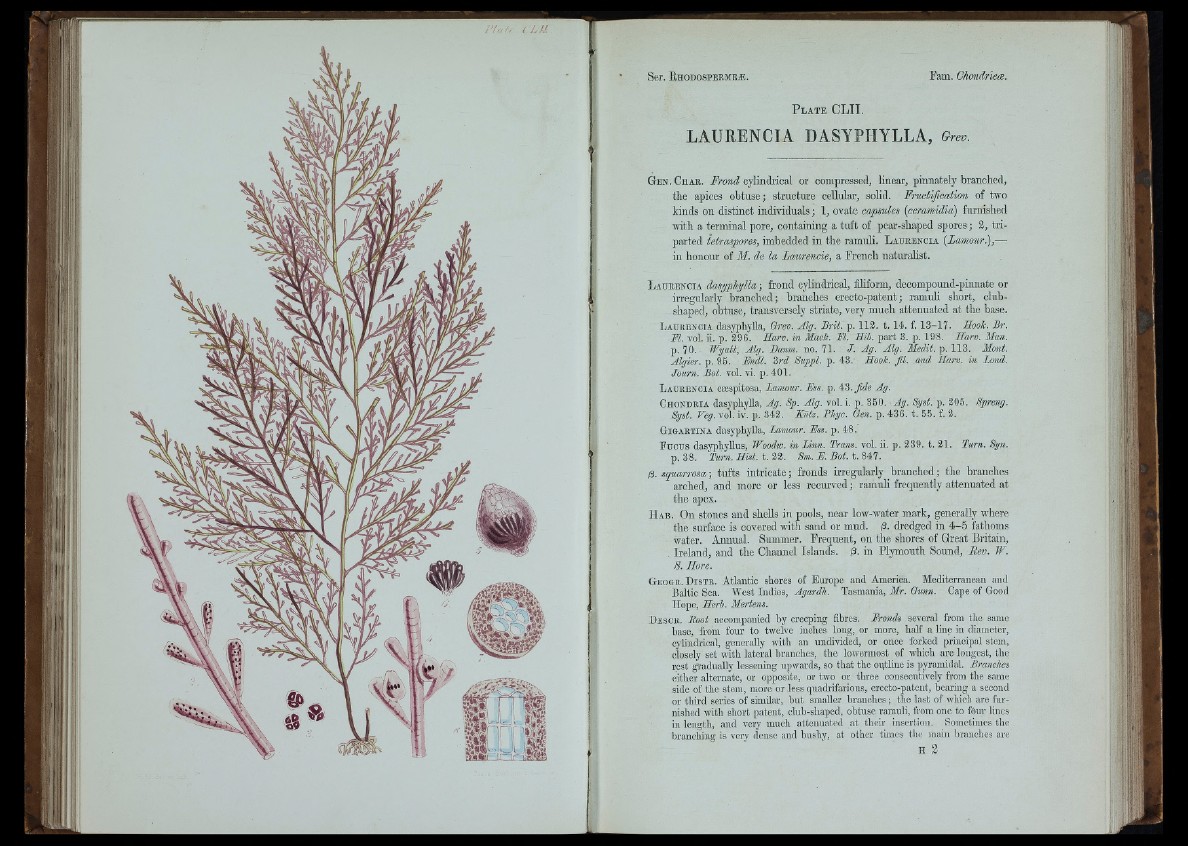
¡V « /, ( L H
P late C L II,
LAURENCIA DASYPHYLLA, Grev.
G e n . Ch a e . Frond cylindrical or compressed, linear, pinnately branched,
the apices obtuse; structure cellular, solid. Fructification of two
kinds on distinct individuals; 1, ovate capsules {ceramidia) furnished
with a terminal pore, containing a tuft of pear-shaped spores; 2, triparted
tetraspores, imbedded in the ramuli. L aueencia {Lammir.),—
in honour of M . de la Laurencie, a French naturalist.
L aueenc ia dasyphylla; frond cylindrical, flhform, decompound-pinnate or
irregularly branched; branches erecto-patent; ramuli short, club-
shaped, obtuse, transversely striate, very much attenuated at the base.
L aurencia dasyphylla. Grew. Alg. Brit. p. 113. 1 .14. f. 13-17. TAooh. Br.
FI. vol. ii. p. 296. H a n . in Mack. FI. Hih. part 3. p. 198. H a n . Man.
p. 70. Wyatt, Alg. Banm. no. 71. J. Ag. Alg. Medit. p. 113. Mont.
Algier. p. 95. Fndl. 3rd Suppl. p. 43. Hook. fil. and Harv. in Bond.
Journ. Bot. vol. vi. p. 401.
L aurencia csespitosa, Lamour. Fss. p. 43. fide Ag.
Ch o n d e ia dasyphylla, Ag. Sp. Alg. vol. i. p. 350. Ag. Syst. p. 205.
Syst. Veg. vol. iv. p. 842. Kiik. Phyc. Gen. p. 436. t. 55. f. 2.
Gigart ina dasyphylla, iMviour. Fss. p. 48.
Fu cu s dasyphyllus, Woodw. in lAnn. Trans, vol. ii. p. 339. t. 21.
p. 38. Turn. Hist. t. 22. Sm. F. Bot. t. 847.
ß. squarrosa-, tufts intricate; fronds irregularly branched; the branches
arched, and more or less recurved; ramuli frequently attenuated at
the apex.
H a b . On stones and shells in pools, near low-water mark, generally where
the surface is covered with sand or mud. ß. dredged in 4 -5 fathoms
water. Annual. Summer. Frequent, on the shores of Great Britain,
. Ireland, and the Channel Islands, ß. in Plymiouth Sound, Rev. W.
8. Hore.
Geogr. D is t r . Atlantic shores of Europe and America. Mediterranean and
Baltic Sea. AVest Indies, Agardh. Tasmania, Mr. Gunn. Cape of Good
Hope, Herb. Ma-tem.
De sc r . Boot aocompanied by creeping fibres. Fronds several from the same
base, from four to twelve inches long, or more, half a line in diameter,
cylindrical, generally with an undivided, or once forked principal stem,
closely set with lateral branches, the lowermost of which are longest, the
rest gTaduahy lessening upwards, so that the oqtline is pyramidal. Branches
either alternate, or opposite, or two or three consecutively from the same
side of the stem, more or less quadrifarious, erecto-patent, bearing a second
or third series of similar, bnt smaller branches; the last of which are furnished
with short patent, club-shaped, obtuse ramuli, from one to four lines
in length, and very much attenuated at their insertion. Sometimes the
branching is vcrv dense and bushy, at other times the main branches arc
H 2